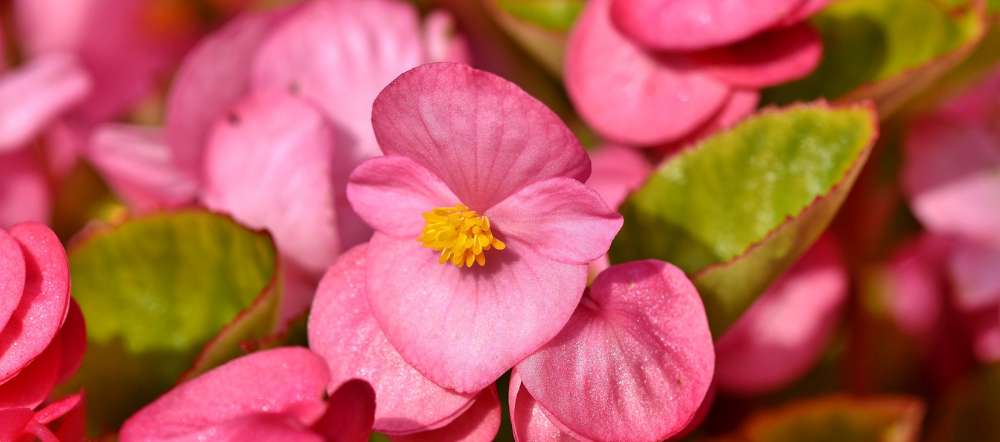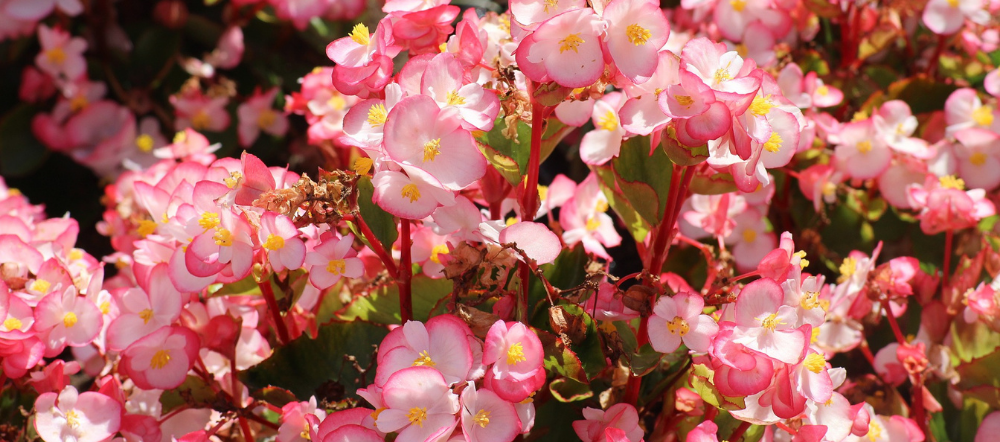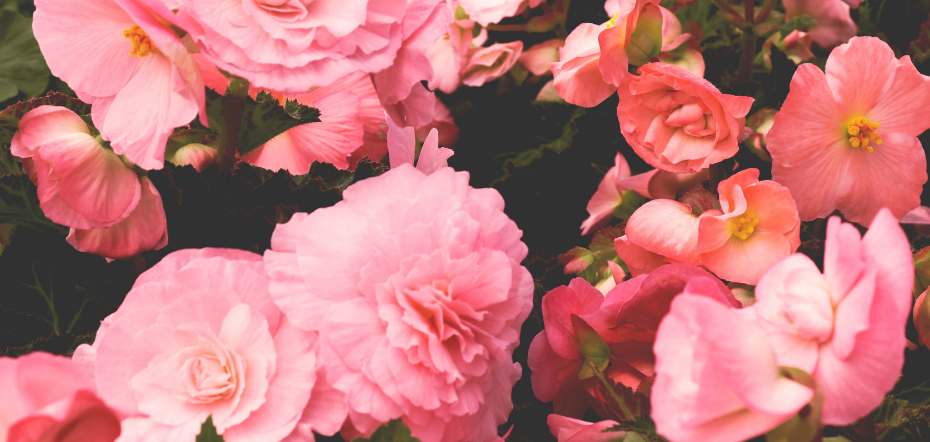With over 1,800 different species, the variety of begonias is astounding. And with each variety comes different colors, leaves, and growing habits.
In this article, we’ll take a look at how to care for begonia plants in general. Plant care will vary depending on the begonia variety, so check your plant’s tag or consult a greenhouse in your area for specific plant care information.
To jump to a specific part of this post, click a link below:
What are begonias?
Begonias are easy-care plants that thrive in sun or shade, with moderate watering and fertilizer needs.
Begonias have been growing in popularity over the years. They are often grown as houseplants (grown year-round as a perennial) or outside in containers and flower beds (grown for one growing season as an annual).
Their beautiful flowers and foliage have made them a favorite among avid gardeners and casual growers alike.
Next, we’ll take a look at how to care for your begonia plants, and provide some tips on growing begonias along the way.

Caring for your begonias
As mentioned, begonias are super easy-care.
That’s not to say they won’t need any attention. They’ll still need to be kept after, but they will be more tolerant if your plant care is lacking.
In comparison to other plants, begonias are a great plant for beginner growers or even just gardeners who don’t have a lot of time to dedicate to growing.
At Homestead Gardens, we grow our begonias as annuals, planting them outside for one growing season, so the focus of this information will be for growers who are growing begonias outside.
In case you are growing your begonia as a house plant, here are some great guides you can take a look at to learn more:
- Everything You Need to Know to Keep Your Begonias Happy Indoors
- How to Grow Begonias Indoors During the Winter
- Growing Begonias Indoors
- Our House Plant’s Guide to Begonias
- Disease and pest control
Now, let’s get into some basic begonia care items for planting begonias as an annual outside.
Sunlight requirements
Due to the wide variety of begonia plant types, sunlight requirements may vary. But most begonias will grow great in either full sun or full shade.
If you are looking for ideal growing conditions, try giving the plant part shade, with 4 to 6 hours of morning sunlight.
At Homestead Gardens, our most popular begonias are Dragon Wing (Angel Wing) and BIG begonias, and both of these varieties thrive in either full sun or full shade.
Begonia temperature needs
Begonias grown outside will be sensitive to early spring cold snaps depending on your location, so be careful that you don’t plant them outside too early.
Ideally, begonias will grow best if they aren’t exposed to overnight temperatures below 60 degrees. This is especially true if the begonia plants are not “hardened off.”
Hardened off simply means that they are hardier due to being exposed to harsh conditions when they were a young plant — an effective strategy for growing healthy annuals.
We recommend waiting until after Mother’s Day to plant begonias outside in Central PA. If you are growing begonias in the more southern parts of the nation you’ll be able to plant them outside earlier than Mother’s Day.
If you are planting them in pots or hanging baskets you have some flexibility. Containers aren’t a problem to bring in your garage or in the house overnight if an unexpected cold snap occurs.

Height and spread of begonias
Begonias can grow as tall and wide as 20″ tall and wide.
Again, this varies according to the type of begonia. While BIG begonias can get as large as 20″, other varieties may max out at 12″ tall.
Soil type
Begonias will grow the best in soil that is well-drained. Begonias, like many other annuals, are prone to root rot if water collects around their roots for too long.
When growing begonias in a flower pot or hanging basket, make sure you have holes for the water to drain out the bottom. Some growers also use false bottoms, such as crumbled-up plastic or pebbles to help with drainage from the root structure.
Begonia water & fertilizer needs
It’s best to water and fertilize begonias throughout the summer to ensure you’ll have beautiful blooms for many months.
Begonias will need a moderate amount of watering, especially during the summer months when the heat sets in.
To determine if your begonia needs watered you can feel the first inch of soil on the surface for moistness/dampness. If it’s completely dried out, that’s a good sign you can give the plant some more water.
If you are growing begonias in a hanging basket, try lifting the basket from beneath to feel the weight of the hanging basket. The more you do this, the better you’ll get a feel for when the plant needs water. If the hanging basket is in need of watering, it’ll feel noticeably light.

Disease and pest control
As mentioned already, root rot is a disease you’ll need to be careful of with begonias. Another common disease is blight. Either of these diseases can stunt the growth of the plant and even kill it.
Here’s a great guide for diagnosing and managing begonia diseases you may run into.
Some common pests of begonias are:
- Mealy bugs
- Spider mites
- Thrips
- Scales
- Snails
- Slugs
Information on how to manage these pests can be found here.
Pruning begonias
Begonias grown as annuals do not need to be pruned. In some cases, you may want to cut back the plant to encourage growth. This isn’t as much of a factor for begonias as other plants, such as wave petunias.
Propagation of begonias
Propagating begonias is possible, but you’ll likely just want to purchase small plants to start if you are growing begonias as an annual. Propagating begonias takes more time for them to get started, so you may not have as long as a growing season.
Here’s a quick overview of how to propagate begonias:
- Cut about a 4″ stem off the mother plant.
- Place the stem(s) in a glass of water (a few inches of water is fine) and place on a windowsill.
- Re-fill the water as needed until the stems begin to sprout tiny roots (may take about a month or so).
- Once the roots are mature enough, plant the cuttings in some well-drained soil and water and fertilizer. The plant may struggle at first in its new environment, but with the proper care, it’ll grow into a begonia plant of its own.

Summary
There are so many benefits of growing begonia plants! Hopefully, these tips for begonia plant care were helpful to you.
As a recap, begonia plants will grow best with well-drained soil, full sun or shade (depending on the plant variety), moderate watering and fertilizing, and a careful watch on diseases and pests.

